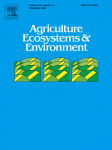Ver ítem
- xmlui.general.dspace_homeCentros Regionales y EEAsCentro Regional Buenos Aires SurEEA BalcarceArtículos científicosxmlui.ArtifactBrowser.ItemViewer.trail
- Inicio
- Centros Regionales y EEAs
- Centro Regional Buenos Aires Sur
- EEA Balcarce
- Artículos científicos
- Ver ítem
Crop intensification with sustainable practices did not increase N2O emissions
Resumen
Nitrous oxide (N2O) is the most important greenhouse gas produced by agricultural soils and is a byproduct of
microbial nitrification and denitrification processes. The N2O emission rates depend on soil, climatic and
management factors. The objectives of this study were i) to evaluate N2O emissions during a barley crop period
and its subsequent barley-maize interperiod, under two management systems, and ii) to relate the N2O flux rates
with soil
[ver mas...]
Nitrous oxide (N2O) is the most important greenhouse gas produced by agricultural soils and is a byproduct of
microbial nitrification and denitrification processes. The N2O emission rates depend on soil, climatic and
management factors. The objectives of this study were i) to evaluate N2O emissions during a barley crop period
and its subsequent barley-maize interperiod, under two management systems, and ii) to relate the N2O flux rates
with soil mineral N content, waterfilled pore space (WFPS) and soil temperature. These periods are part of threeyear
crop sequence (barley - maize - soybean) of a long-term experiment under two management systems,
ecological intensification (EI) and farmer current practices (FP). For the analyzed period, the EI system included
a cover crop after barley and higher N rates, with split application, compared to FP. N2O emissions were
monitored weekly using a static chambers method. Simultaneously, the mineral N content (NO3–N and NH4+-
N), WFPS and soil temperature at 10 cm depth were determined. The flux of N2O-N ranged from 6 to 61 μg of
N2O-N m2 h-1 during the barley crop and between 1.5 and 47 μg of N2O-N m2 h-1 during the barley-maize
interperiod, without significant differences between management systems. N2O emissions were controlled by
soil temperature and %WFPS according to a multiple regression analysis. NH4+-N and NO3–N soil content did
not enter into any model as a regulator of N2O flux. During the barley period there was a significant effect of the
WFPS×soil temperature interaction since N2O emissions increased with soil temperature only at WFPS > 40
%. During the barley-maize interperiod, there were significant positive effects of WFPS and temperature on N2O
emissions with no significant WFPS x temperature interaction. The cumulative emissions of N2O-N were not
different between management systems during the barley crop (IE=646 and FP=757 g N2O-N ha-1) or during
barley-maize interperiod (IE=816 and FP=754 g N2O-N ha-1). Throughout the study period, the combination
of management practices in EI increased barley yield and did not increase N2O emissions with respect to FP,
despite higher N rates and the inclusion of cover crop in EI. The intensification of crops does not necessarily
increase N2O emissions from agricultural soils as long as the crops are conducted with appropriate management
practices.
[Cerrar]

Fuente
Agriculture, Ecosystems and Environment 292 : 106828 (2020)
Fecha
2020-04-15
Editorial
Elsevier
ISSN
0167-8809
Formato
pdf
Tipo de documento
artículo
Palabras Claves
Derechos de acceso
Restringido
 Excepto donde se diga explicitamente, este item se publica bajo la siguiente descripción: Creative Commons Attribution-NonCommercial-ShareAlike 2.5 Unported (CC BY-NC-SA 2.5)
Excepto donde se diga explicitamente, este item se publica bajo la siguiente descripción: Creative Commons Attribution-NonCommercial-ShareAlike 2.5 Unported (CC BY-NC-SA 2.5)

